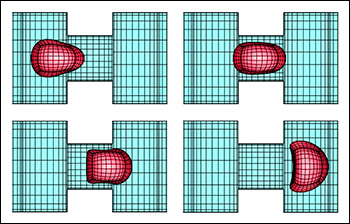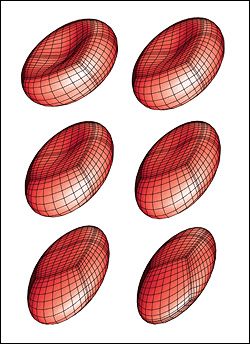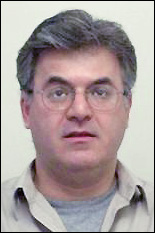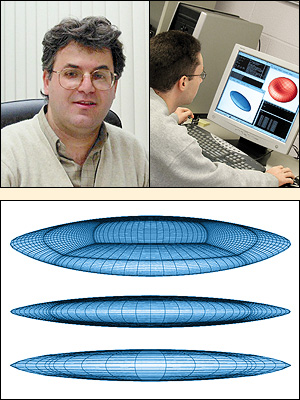News Story
Dimitrakopoulos Wins 2 NSF Grants
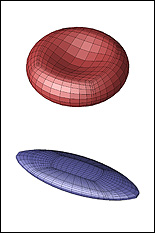
Above: A computer model of a red blood cell. Below: A computer model of an artificial capsule. Capsules are used in a variety of inductrial applications, including drug delivery and in products that require controlled release of active principles, aromas or flavors.
ChBE professor Panos Dimitrakopoulos has recently been awarded two NSF grants: one on "Hemodynamics in the Microcirculation", and the other on "Novel Computational Algorithms for Capsules and Biological Cells". The research will be conducted in Dimitrakopoulos' Biofluid Dynamics Laboratory, which applies novel computational and theoretical methodologies for the accurate and efficient study of the dynamics of red blood cells, artificial capsules, drops and biopolymers. The first study, titled "Computational Studies on Hemodynamics in the Microcirculation", investigates the motion of red blood cells, which are 8 microns in diameter, through vascular microvessels, which can be as small as 3-4 microns in diameter. This study has long been recognized as a fundamental problem in physiology and biomechanics, since the cells' main function of exchanging oxygen and carbon dioxide with tissues occurs in capillaries. Unfortunately, direct measurements of pressure gradients, and therefore wall shear stress, in microvascular segments are scarce since they require the simultaneous insertion of two micropipettes into a vessel segment, a process that is technically very difficult. This makes a computer-modeled investigation in the microcirculation, like Dimitrakopoulos', an attractive alternative. The proposed study focuses on the resistance of blood flow which is known to occur mainly in the microcirculation of the body. It also helps to understand the lifetime of red blood cells since their large deformations and the associated large interfacial stresses generated by their passing through capillaries may damage their membranes and accelerate the aging process. Of particular interest is the variation of hematocrit (the proportion of blood volume occupied by red blood cells) and the changes in the blood's apparent viscosity (known as the Fahraeus effect) that occurs in these vessels due to the strong hydrodynamic interactions of the cells with the vessel walls. The physical understanding derived from this research has the potential to enhance human health. The second study, titled "A Fully-Implicit Spectral Boundary Element Algorithm for Capsules and Biological Cells", focuses on the dynamic behavior of membrane-enclosed fluid volumes such as artificial capsules, vesicles, and red blood cells. These are involved in physiological processes within the body, and are found in a broad range of industrial applications. For example, in pharmaceutical processes, capsules are commonly used for drug transport and delivery. Polishes, paints, cosmetics, and many foods also involve the use of membrane-enclosed fluid volumes for the controlled release of active principles, aromas or flavors. Understanding the dynamic behavior of these systems is a complicated problem due to the combination of the fluid mechanics with the elastic properties of the interfacial membrane. To overcome this obstacle, Dimitrakopoulos has proposed the development of a novel computational methodology based on the Spectral Boundary Element Algorithm for Interfacial Dynamics in Stokes Flow. The proposed algorithm has the ability to accurately and efficiently determine the membrane's interfacial properties, produce high-quality results, and facilitate the investigation of complicated problems involving three-dimensional capsules, vesicles and biological cells in confined solid geometries such as microfluidics and blood capillaries. To learn more about Professor Dimitrakopoulos' work and research group, visit http://www.eng.umd.edu/~dimitrak/
Published September 5, 2007



